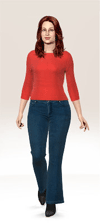Sunday, January 18, 2004
Wish List Item #1: Amy Avatar-TM

May this post represent my formal request to the tech developers of the world to put down their work on those idiotic combo camera-phones and apply their formidable creativity toward the development of individualized 3D avatars for virtual apparel shopping.
The problem is this: clothing that fits well is difficult to find because there is a fairly large variation in the shape of our bodies. This means you can either wear things that don't require a good fit (e.g. T-shirts, fleeces, and baggy pants) or you can spend many hours and many dollars finding a well tailored item. A prime example of this dilemma is the fit of women's blue jeans. The discordance between the design of most jeans and the actual shape of most women's bodies is laughably high. Truly, I suspect I could assemble a respectable freakshow by hiring the fit-models for five randomly selected pairs of jeans. You know that something is wrong with the system when a person like myself (5'2", two symmetrical legs, no tail, average build, modest income) has turned down, literally, hundreds of pairs of jeans due to fit, but NEVER ONCE due to price. The demand is there, the goods are not.
Imagine, however, that for a modest sum and the time it would take to undress only once, you could get a virtual and accurate 3D model of your own body. You could then use this avatar online to "try on" clothes. At the simplest level, your avatar would just be the collection of your volumetric measurements taken while standing by the same sort of body scanning technology used to create special effects animation for the movies. At a more sophisticated level, your avatar could include information about your coloration, range of motion, and flesh quality (i.e. jiggle factor). With a fair amount of effort, it might even look and move reasonably like you.
For a consumer with an avatar, "trying on" clothes at online stores would be near instantaneous. No undressing, no fussing with zippers and buttons, no limit of eight items, no begging sales people to get you another size. Alterations could be negotiated before the item was shipped out, and some articles could even be custom made. Should you choose to visit an actual mall, you could still carry the information about yourself on your PDA. By comparing your own measurements to those of an article of clothing, information that could be found, for example, on a microchip embedded in the tag, you would know whether it was worth your time to bring that item into the dressing room. "Beep! Warning: this item is volumetrically incompatible with your ass." How useful!
Avatar technology would also be helpful to the retailer as well. More online shopping would mean fewer actual stores and lower overhead. Designers could collect the aggregate data of their customers and improve on the fit of their products. Shoplifting would be a thing of the past. Clothing could even be assembled AFTER it was purchased, given some advancement in production technology, thus reducing overstock.
The apparel industry is clearly headed in this direction. Some retailers, notably Lands End and J.C. Penny, are currently using software by My Virtual Model to generate images that you can customize to look more like you. The one I generated for myself (see above) looks more like me than, say, Kate Moss, but that's about it. This probably appeals to the same sort of politically correct people who lobby against Barbie dolls, but it's not really useful.
However, there are some real advances in 3D rendering toward the goal of overhauling the apparel industry. Researchers at the Department of Textiles and Apparel at Cornell are working on a body scanning booth that uses 8 cameras and 4 lasers to generate fairly good surface renderings. Also, a non-profit group called TC2 has been using body scanning to collect data about the populace and provide consulting to the garment industry.
Still, we have a ways to go before I can shop for jeans from home.
posted by Amy
3:41 PM

